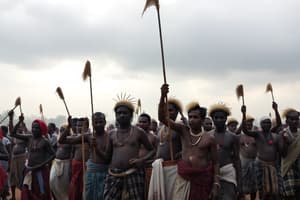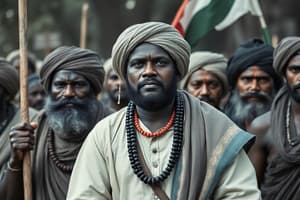Podcast
Questions and Answers
What problems did Birsa set out to resolve?
What problems did Birsa set out to resolve?
Birsa aimed to save his people from trouble and free them from the slavery of dikus.
Who were the outsiders being referred to as dikus?
Who were the outsiders being referred to as dikus?
Dikus were outsiders, or non-tribal people, who enslaved the local tribal communities.
How did the lives of tribal people change under British rule?
How did the lives of tribal people change under British rule?
Their familiar ways of life seemed to be disappearing, their livelihoods were under threat, and their religion appeared to be in danger.
How did tribal groups practice jhum cultivation?
How did tribal groups practice jhum cultivation?
Birsa was born into a family of Santhals.
Birsa was born into a family of Santhals.
Jhum cultivation is a form of ______ cultivation.
Jhum cultivation is a form of ______ cultivation.
What is the significance of the ash spread by jhum cultivators?
What is the significance of the ash spread by jhum cultivators?
Flashcards are hidden until you start studying
Study Notes
Birsa Munda and the Fight Against the Dikus
- Birsa Munda, a leader of the Mundas, was seen as a savior by many tribal people in the Chottanagpur region of Jharkhand.
- Birsa claimed to have miraculous powers and believed he was sent by God to free his people from the oppression of the dikus.
- Birsa gathered a large following that included Mundas, Santhals, and Oraons, all of whom faced challenges under British rule.
Traditional Tribal Life Disrupted
- The British colonial rule in Chottanagpur had a negative impact on tribal communities.
- Their traditional ways of life were threatened, and their livelihoods were disrupted.
- The British imposed changes that challenged tribal customs and beliefs.
Shifting Cultivation and Tribal Life
- Shifting cultivation, also known as jhum cultivation, was a common practice among tribal groups throughout India.
- This method involved clearing patches of forest land through cutting and burning vegetation, allowing sunlight to reach the ground.
- The ash from burning served as a natural fertilizer.
- The practice involved moving to new fields after the harvest to allow land to recover its fertility.
- This type of cultivation was prevalent in hilly and forested regions of central and northeastern India.
- Tribal communities relied on access to forests and freedom of movement for their survival.
Studying That Suits You
Use AI to generate personalized quizzes and flashcards to suit your learning preferences.




